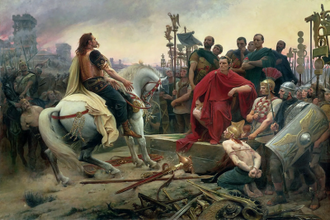Gospel in Art: Give back to Caesar what belongs to Caesar

Vercingetorix throws down his arms at the feet of Julius Caesar, by Lionel Royer, 1899 © Musée Crozatier, Auvergne, France
Source: Christian Art
Gospel of 22 October 2023
Matthew 22:15-21
The Pharisees went away to work out between them how to trap Jesus in what he said. And they sent their disciples to him, together with the Herodians, to say, 'Master, we know that you are an honest man and teach the way of God in an honest way, and that you are not afraid of anyone, because a man's rank means nothing to you. Tell us your opinion, then. Is it permissible to pay taxes to Caesar or not?'
But Jesus was aware of their malice and replied, 'You hypocrites! Why do you set this trap for me? Let me see the money you pay the tax with.'
They handed him a denarius, and he said, 'Whose head is this? Whose name?' 'Caesar's' they replied. He then said to them, 'Very well, give back to Caesar what belongs to Caesar - and to God what belongs to God.'
Reflection on the painting
The Pharisees set a very clever trap for Jesus in today's reading, by asking him 'Is it permissible to pay taxes to Caesar or not?' If Jesus advised Jews to pay the tax, they would condemn him for recognising the pagan Roman authorities occupying their land. On the other hand, if Jesus told the Pharisees not to pay the tax, they could have told the Romans that Jesus was spreading civil disobedience and have him arrested. It was a no-win situation, but Jesus outsmarted them all. He simply asked one of the Pharisees to produce a denarius, which would be the very coins they used to pay the tax with. Possessing that Roman coin was in itself an admission that they were compromised as loyal Jews… they had fallen into their own trap!
Jesus simply states 'Give back to Caesar what belongs to Caesar'… In our painting today we see Caesar in full action as an emperor ruling territories. It depicts the surrender of the Gallic chieftain after the Battle of Alesia (52 BC). The Gauls are shown with long hair and moustaches. The Romans are looking on, full of confidence, arrogance and pride: they won the war. Just as Gaul became part of the Roman Empire, so did the Jewish territories. These Jewish territories were important to Rome, mainly because they lay between Syria and Egypt, two of Rome's most valuable possessions.
Our painter Lionel Royer volunteered before his 18th birthday for the Franco-Prussian War. He thus was familiar with battles , putting him in a prime position to depict war scenes. He obtained the prestigious Prix de Rome in 1882. The horse and shield in our painting are something of an anachronism. The horse is a Percheron, though this breed did not exist yet in Roman times in Gaul. The rectangular shield also does not accord with the time, when they were mostly circular or oval. No gallic shields of rectangular form were ever found.
LINKS
Gospel in Art: https://christian.art/
Today's Reflection: https://christian.art/daily-gospel-reading/matthew-22-15-21-2023/


















